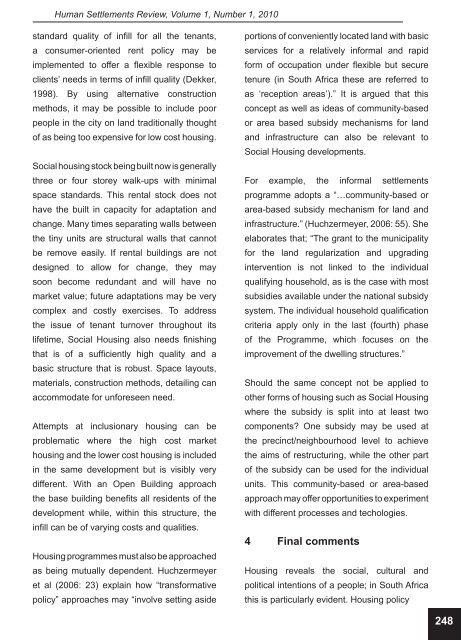Human Settlements Review - Parliamentary Monitoring Group
Human Settlements Review - Parliamentary Monitoring Group
Human Settlements Review - Parliamentary Monitoring Group
Create successful ePaper yourself
Turn your PDF publications into a flip-book with our unique Google optimized e-Paper software.
<strong>Human</strong> <strong>Settlements</strong> <strong>Review</strong>, Volume 1, Number 1, 2010<br />
standard quality of infill for all the tenants,<br />
a consumer-oriented rent policy may be<br />
implemented to offer a flexible response to<br />
clients’ needs in terms of infill quality (Dekker,<br />
1998). By using alternative construction<br />
methods, it may be possible to include poor<br />
people in the city on land traditionally thought<br />
of as being too expensive for low cost housing.<br />
Social housing stock being built now is generally<br />
three or four storey walk-ups with minimal<br />
space standards. This rental stock does not<br />
have the built in capacity for adaptation and<br />
change. Many times separating walls between<br />
the tiny units are structural walls that cannot<br />
be remove easily. If rental buildings are not<br />
designed to allow for change, they may<br />
soon become redundant and will have no<br />
market value; future adaptations may be very<br />
complex and costly exercises. To address<br />
the issue of tenant turnover throughout its<br />
lifetime, Social Housing also needs finishing<br />
that is of a sufficiently high quality and a<br />
basic structure that is robust. Space layouts,<br />
materials, construction methods, detailing can<br />
accommodate for unforeseen need.<br />
Attempts at inclusionary housing can be<br />
problematic where the high cost market<br />
housing and the lower cost housing is included<br />
in the same development but is visibly very<br />
different. With an Open Building approach<br />
the base building benefits all residents of the<br />
development while, within this structure, the<br />
infill can be of varying costs and qualities.<br />
Housing programmes must also be approached<br />
as being mutually dependent. Huchzermeyer<br />
et al (2006: 23) explain how “transformative<br />
policy” approaches may “involve setting aside<br />
portions of conveniently located land with basic<br />
services for a relatively informal and rapid<br />
form of occupation under flexible but secure<br />
tenure (in South Africa these are referred to<br />
as ‘reception areas’).” It is argued that this<br />
concept as well as ideas of community-based<br />
or area based subsidy mechanisms for land<br />
and infrastructure can also be relevant to<br />
Social Housing developments.<br />
For example, the informal settlements<br />
programme adopts a “…community-based or<br />
area-based subsidy mechanism for land and<br />
infrastructure.” (Huchzermeyer, 2006: 55). She<br />
elaborates that; “The grant to the municipality<br />
for the land regularization and upgrading<br />
intervention is not linked to the individual<br />
qualifying household, as is the case with most<br />
subsidies available under the national subsidy<br />
system. The individual household qualification<br />
criteria apply only in the last (fourth) phase<br />
of the Programme, which focuses on the<br />
improvement of the dwelling structures.”<br />
Should the same concept not be applied to<br />
other forms of housing such as Social Housing<br />
where the subsidy is split into at least two<br />
components One subsidy may be used at<br />
the precinct/neighbourhood level to achieve<br />
the aims of restructuring, while the other part<br />
of the subsidy can be used for the individual<br />
units. This community-based or area-based<br />
approach may offer opportunities to experiment<br />
with different processes and techologies.<br />
4 Final comments<br />
Housing reveals the social, cultural and<br />
political intentions of a people; in South Africa<br />
this is particularly evident. Housing policy<br />
248









![National Research Foundation Annual Report 2008 / 2009 [Part 2]](https://img.yumpu.com/49774036/1/177x260/national-research-foundation-annual-report-2008-2009-part-2.jpg?quality=85)







